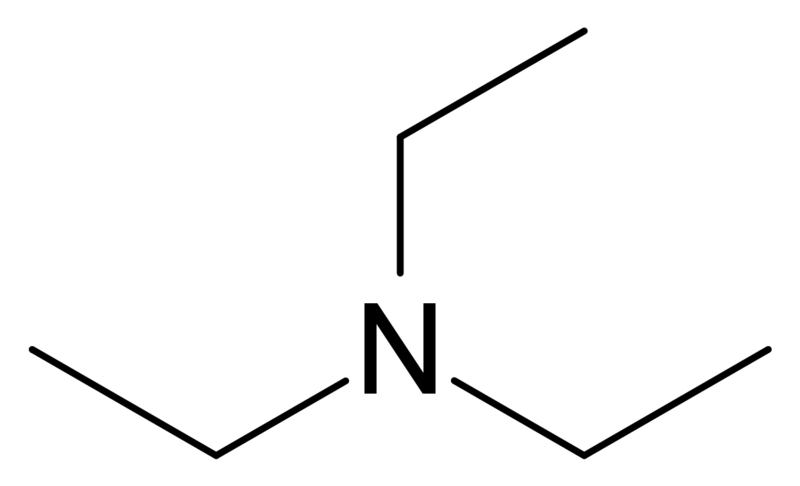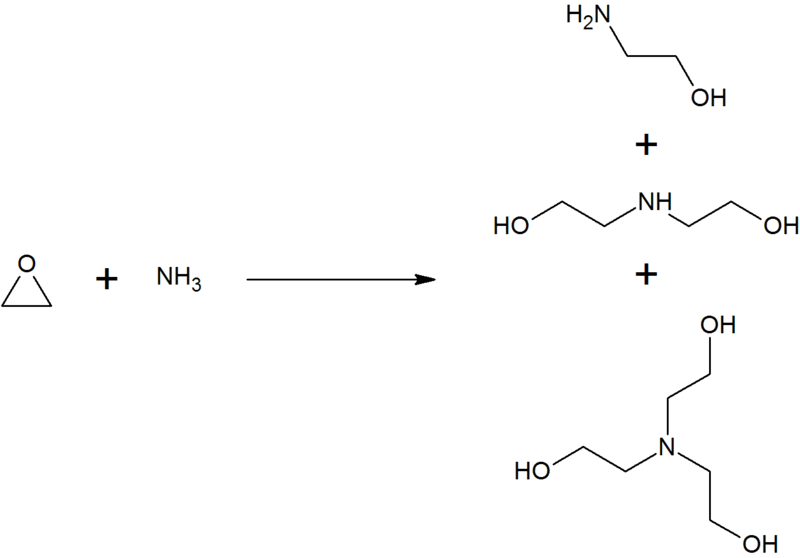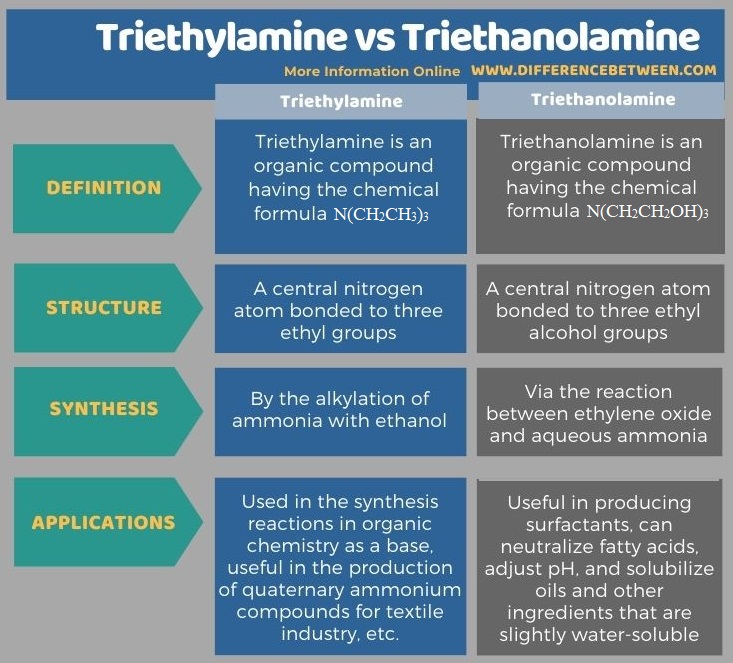Difference Between Triethylamine and Triethanolamine
Table of Contents
The key difference between triethylamine and triethanolamine is that triethylamine contains three ethyl group attached to the same nitrogen atom whereas triethanolamine contains three ethyl alcohol groups attached to the same nitrogen atom.
The chemical compounds triethylamine and triethanolamine are organic compounds containing nitrogen atoms. These compounds have a nitrogen atom at the centre of the molecule, and there are three organic moieties attached to the nitrogen centre.
CONTENTS
1. Overview and Key Difference
2. What is Triethylamine
3. What is Triethanolamine
4. Side by Side Comparison – Triethylamine vs Triethanolamine in Tabular Form
5. Summary
What is Triethylamine?
Triethylamine is an organic compound having the chemical formula N(CH2CH3)3. This compound is abbreviated as Et3N. It is in the liquid state at room temperature, and it appears as a volatile, colourless liquid. It has a strong fishy odour that resembles the odour of ammonia.

Figure 01: Chemical Structure of Triethylamine
Triethylamine can be produced by the alkylation of ammonia with ethanol. The pKa of this liquid is about 10.75 so, it can be used for the preparation of buffer solutions around pH 10.75. Triethylamine is slightly water-soluble. However, it is miscible with some organic solvents as well. e.g. acetone, ethanol, etc. The hydrochloride salt of triethylamine is triethylamine hydrochloride, which is a colourless, odourless, and hygroscopic powder.
There are many important applications of triethylamine. Commonly, it is used in the synthesis reactions in organic chemistry as a base. E.g. preparation of esters, amides from acyl chlorides. Furthermore, it is useful in the production of quaternary ammonium compounds for the textile industry. It is also useful as a catalyst and an acid neutralizer for condensation reactions. Moreover, it is useful as an intermediate for manufacturing medicines, pesticides, etc.
What is Triethanolamine?
Triethanolamine is an organic compound having the chemical formula N(CH2CH2OH)3. It contains three alcohol groups attached to a central nitrogen atom. Therefore, we can classify it as a triamine and as a triol. This compound occurs as a colourless and viscous liquid at room temperature. However, if it contains impurities, this liquid appears in yellow colour.
We can produce triethanolamine via the reaction between ethylene oxide and aqueous ammonia. However, this reaction can produce ethanolamine and diethanolamine, as well. By changing the stoichiometry of the reactants, we can change the ratio of the products produced from this reaction.

There are many applications of triethanolamine. Primarily, it is useful for producing surfactants. Moreover, it is a common ingredient in both industrial and consumer products. Triethylamine can neutralize fatty acids, adjust pH, and solubilize oils and other ingredients that are slightly water-soluble.
What is the Difference Between Triethylamine and Triethanolamine?
Triethylamine and triethanolamine are organic compounds containing nitrogen atoms at the centre of the molecule. The key difference between triethylamine and triethanolamine is that triethylamine contains three ethyl group attached to the same nitrogen atom whereas triethanolamine contains three ethyl alcohol groups attached to the same nitrogen atom. Triethylamine is an amine compound, while triethanolamine is an alcoholic compound.
Moreover, triethylamine has a central nitrogen atom bonded to three ethyl groups while triethanolamine has a central nitrogen atom bonded to three ethyl alcohol groups. So, this is a structural difference between triethylamine and triethanolamine.
Below infographic tabulates more differences between triethylamine and triethanolamine.

Summary – Triethylamine vs Triethanolamine
Triethylamine and triethanolamine are organic compounds containing nitrogen atoms at the centre of the molecule. The key difference between triethylamine and triethanolamine is that triethylamine contains three ethyl group attached to the same nitrogen atom whereas triethanolamine contains three ethyl alcohol groups attached to the same nitrogen atom.
Reference:
1. “Triethanolamine.” Wikipedia, Wikimedia Foundation, 18 Mar. 2020, Available here.
Image Courtesy:
1. “Triethylamine” By Mixtures, redrawn by Leyo – Own work (Public Domain) via Commons Wikimedia
2. “Reaction of ethylene oxide with ammonia” By Rifleman 82 – Klaus Weissermel, Hans-Jürgen Arpe, Charlet R. Lindley, Stephen Hawkins (2003) "Chap. 7. Oxidation Products of Ethylene" in Industrial Organic Chemistry, Wiley-VCH, pp. 160 ISBN: 3527305785 (Public Domain) via Commons Wikimedia
ncG1vNJzZmivp6x7pbXFn5yrnZ6YsqOx07CcnqZemLyue8OinZ%2Bdopq7pLGMm5ytr5Wau27A0aKcraCpoa6utc2eZJqmlGLBs7XErZ%2Bapp%2Bhrq61zZ5m